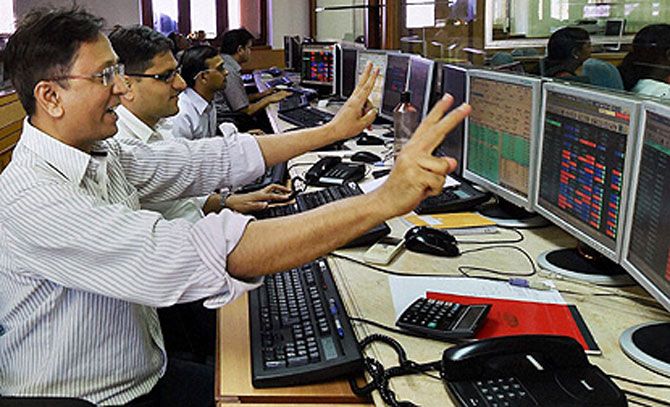And why markets could give up 25 per cent of all these gains made since March 2020.

The 50-stock NSE had hit a low of 7511.10 on March 24, 2020; as of November 22, 2020, the NSE had closed at 12926.25, a gain of whopping 72 per cent in eight months.
In the first part of an interview with Prasanna D Zore/Rediff.com, Dr Joseph Thomas, head of research, Emkay Wealth Management, lists important reasons why the stockmarket staged a sharp recovery in such a short time.
What are the major fundamental reasons for the stockmarkets to stage a V-shaped recovery since March 2020 when we hit the COVID-19 low?
Talking about the fundamental reasons why the markets moved up there are two reasons which need to be highlighted: Hope and liquidity.
The RBI and the Government of India have already taken a number of steps, especially the RBI, which has resulted in very smooth liquidity conditions in the interbank market -- interbank market is where banks borrow and lend money.
The surplus has always been to the tune of about Rs 5 lakh crore-Rs 6 lakh crore, which is actually supplied by the RBI. So this liquidity has given confidence to the markets. And then the same is the case with other countries as well.
The US has also injected about $3.5 trillion-$4 trillion into the system; the European Central Bank has also injected liquidity into the economies of various EC countries.
So all these economies including India have been injecting liquidity into the system and liquidity by its very nature brings down the interest rates.
The RBI has been cutting interest rates, the Federal Reserve Bank of New York was cutting interest rates; the US Fed rate is 0.25 per cent; then the ECB also cut the rates.
Surplus liquidity and low interest rates are the primary factors which have propelled equity markets to higher levels.
Hope is linked to the fact that people expect the growth rates to improve going ahead.
For this whole year, financial year 2020-2021, GDP contraction is expected to be about minus 8 per cent to minus 9 per cent.
It is confirmed that there will be a contraction on account of the economic slowdown, loss of jobs, loss of employment and therefore demand destruction and so many other factors which have come with the pandemic.
There is a hope that as we move on to FY 2021-2022 things will be much better because of all these actions (stimulus packages) taken by the government and the RBI and also better global conditions.
We will move into positive growth right in the next year. There is a very prominent school which believes that the growth could be something around five to six per cent.
There are people who say that the growth could be eight to ten per cent, but I think 5-6 per cent GDP growth would look more reasonable and practicable.
How has this low interest rate regime, or the surplus liquidity injected by the RBI and various stimulus packages announced by the government of India, helped Indian markets stage a V-shaped recovery?
The low interest rate regime has helped Indian corporates raise money at very low cost.
The one-year CP rate (commercial paper) issued by a company is the money it raises for one year and it has come down to around four per cent.
It is a very low rate and its cheap liquidity for the corporates for the next one year.
For the five-year or ten-year paper too the rates have come down. Therefore, the corporates are enjoying lower cost of borrowing.
This should help them generate more profits and reduce their interest cost because lot of companies which are in the mid-cap or small-cap group, or mainly companies in the SME segment, are mostly companies which borrow quite a lot for their business requirements.
The borrowings of these companies, which were say at eight per cent 12-24 months back, has now come down to half of what it was at four per cent.
Borrowing rates have substantially got reduced for the corporate segment. They can mobilise money at around 4 per cent. That's a good rate.
Which are the domestic sectors that will benefit hugely in the next three to five years because of the cheap liquidity available today?
Liquidity has no sectoral implications. Liquidity cannot be linked to any particular sector.
The low interest rate regime could definitely help the banking sector to some extent because when corporates borrow and spend more the cost of borrowing or cost of getting deposits will come down.
So NBFCs, which were facing adverse environment earlier and were not able to get sufficient liquidity could become beneficiaries too.
Otherwise, from high liquidity and low interest rate scenario, irrespective of sector in terms of market cap, it will be the mid-cap and small-cap segments which will benefit.
How do you look at current market valuations in the context of high liquidity and lower interest rate regime?
At this point of time, as things stand, suppose if you are taking a snapshot of the markets today, the market valuations do not look cheap or reasonable which means that they have become slightly expensive.
Now, if you look at the second quarter earnings for 2020-2021, it has been a positive surprise.
In fact, it was expected that corporate earnings will be quiet depressed (for Q2 FY20-21; July-Sep quarter); but we found that the real outperformance has come at the EBITDA levels (a measure of corporate performance at operational level).
What has helped the companies post good performance in the second quarter is lower input prices and the fact that most companies focused on cost control.
What we feel is for the whole year, because we have had contraction in GDP growth of minus 8 to minus 9 per cent this year, followed by a better-than-expected Q2FY20-21 numbers, the expectation now is of better performance in Q3 (Oct-Dec 2020) and Q4 (Jan-Mar 2021).
As we move into the next year (FY21-22), growth rate could be still better.
If you look at the quarterly performance from this perspective, the valuations do not look that expensive. But they are not cheap either.
If they are not cheap, and they are also not very expensive, are you looking forward to a decent correction going ahead?
I will not say that there may be too many deep corrections because the markets are facing two-fold challenges.
How are we going to contain the pandemic because the pandemic is raging in the US? In fact, it has paralysed countries like Germany, France, Italy as they are again in complete and rigorous lockdowns.
What I am saying is we have not been able to contain the pandemic and we haven't yet got an operational vaccine; some of the vaccines require -70 degree Celsius temperature for transporting and doing it will be very difficult in India or in many African countries.
Given this challenge, access to vaccine for people would be quite limited and we yet don't know how expensive it would be; it may not be possible for an ordinary person or a citizen to pay Rs 2,000-Rs 3,000 for the vaccine.
Affordability and accessibility of the vaccine is also important.
In India, we have just seen the first wave of the pandemic; there could be a second wave, and it could be very disastrous if you don't take sufficient precautions.
This pandemic and the potential for a further lockdown, is a major threat to the markets and if that lockdown happens you could see some correction in the markets.
The correction may not be as sharp as we saw in February-March, but maybe 25 per cent of that fall is possible if the pandemic leads to further lockdown in India, and also globally, where one is already witnessing the second wave and lockdown.
The second challenge to the markets, apart from this pandemic, is that inflation is rising in all the major economies. In India, the CPI, the Consumer Price Index, is 7.61 per cent and food inflation is 11 per cent.
Lot of people expected that inflation would come down because the high print was due to the higher prices of fruits and vegetables in the last month and the month before that.
The feeling was that once we get a good crop of fruits and vegetables, after the monsoon things could normalise and then the fruits and vegetables prices could come down.
To add to this, prices of other food items, especially protein foods like eggs or milk has also gone up quite a bit. This means that the inflationary pressure has spread to other food items as well. So, inflation for food items will only stay high.
In the US also, the forecast that has been given from some quarters -- majority of people have forecasted that inflation could be three to four per cent in the next two to three years, which means US inflation which is at 1.8 per cent today is likely to be at around 3.5-4 per cent in the next two to three years, which means inflation is expected to rise in the US too.
From the low of around half per cent the US 10-year treasury bond yield has moved up to 1 per cent. This happened about two weeks back. It is expected to move up further mainly because of these high inflation expectations.
I feel that inflation, if it is persistent, will not allow the RBI to cut interest rates further.
This may suggest that the RBI may hike interest rates, but RBI may not hike interest rates because the rate of economic growth is expected to be a contraction of minus 8 to 9 per cent.
The street's expectations that the RBI may cut rates at least once will also not happen.
Also, the RBI which has injected five to six lakh crores rupees into the system could partially withdraw that liquidity and bring it down to Rs 4 lakh crores or Rs 3 lakh crores citing high level of inflation in not only commodities and consumption goods, but also in asset markets.
The RBI could suck out liquidity to bring inflation down.
The threats the equity markets today face are the pandemic and when are we going to control it, when do we get a vaccine, how are we going to combat the second wave and what are the measures we will be able to take or is there a top possibility of another rigorous lockdown by the time we have a second wave.
We may have a second image which will be strong or weak. If it is going to be strong, then it could lead to some correction in the markets because there will be complete lockdown and businesses, industries and factories will be closing down, no transport, no airline and that could again lead to some kind of correction, but it may not be as deep as what we saw in March.
The third risk is the border issues with China. If it flares up into a conflict between the two nations, then that may have some impact on the markets with overseas investors selling and exiting the market. These are the negative things about the markets.
One positive factor for the markets is that we have been seeing very good inflows from the FIIs.
And there is a trend of money moving from US and Europe into emerging markets because it is expected that EMs may be relatively better positioned and prepared and could give higher returns.
Also, once Joe Biden becomes president of the USA, he is likely to infuse more liquidity into the US system compared to the Republicans, who were expected to put in around 1.8 trillion US dollars.
Biden, on the other hand, is expected to inject 2.5 to three trillion US dollars, because he is expected to put more money into the hands of the people and into the US economy.
Therefore, the part of those monies could find its way into India and other EMs.
Photograph: Reuters











 © 2025
© 2025